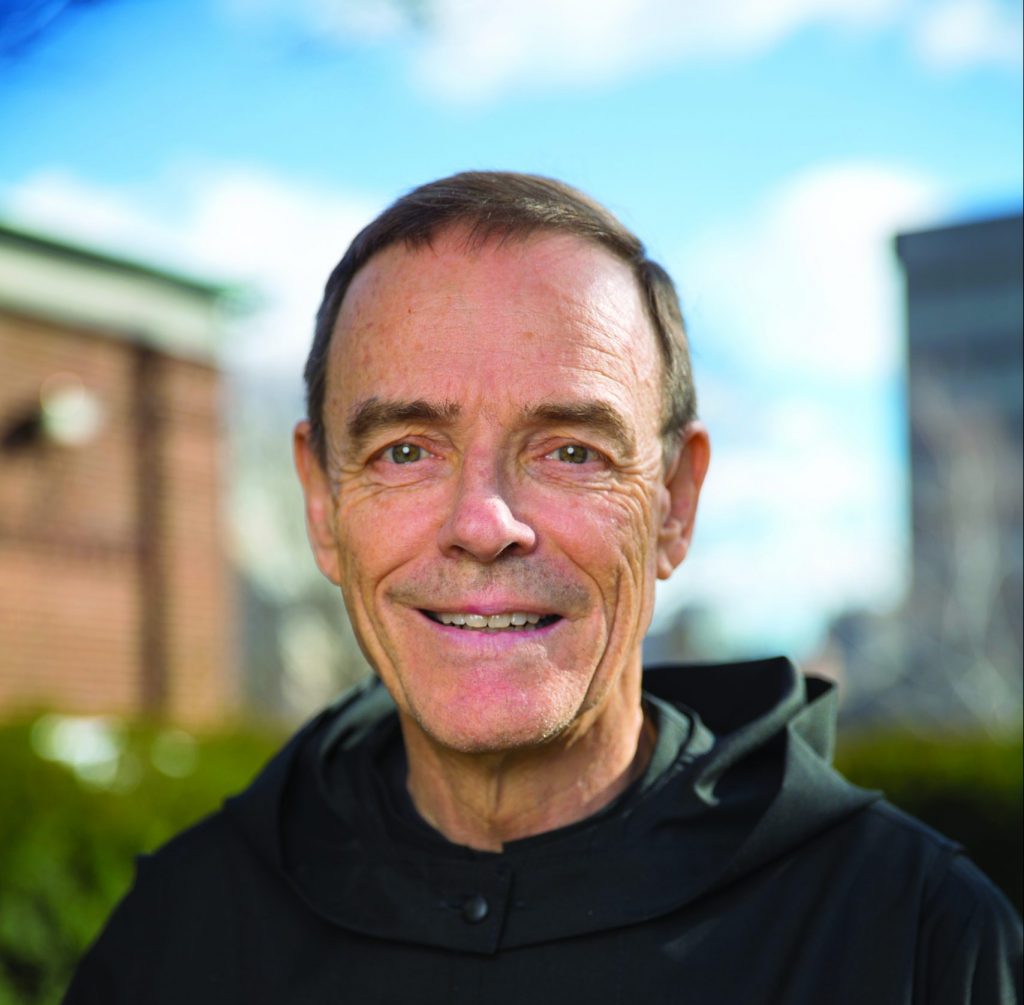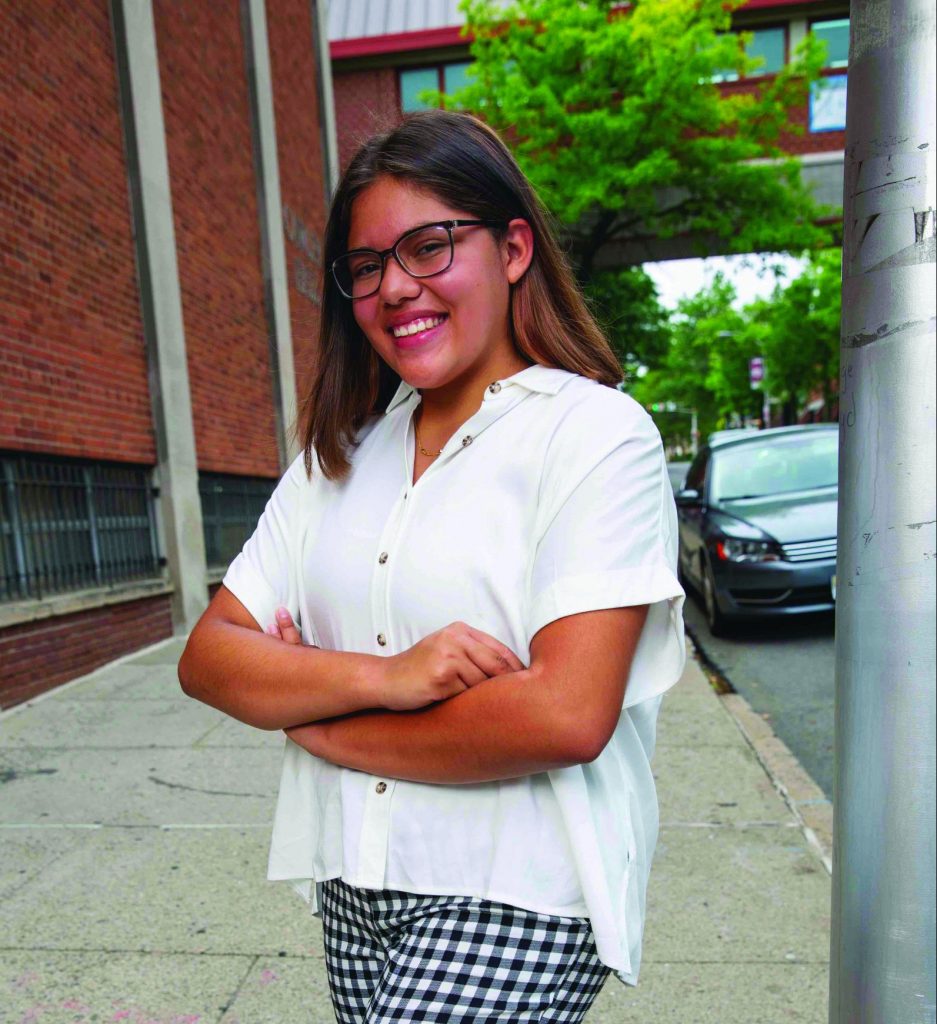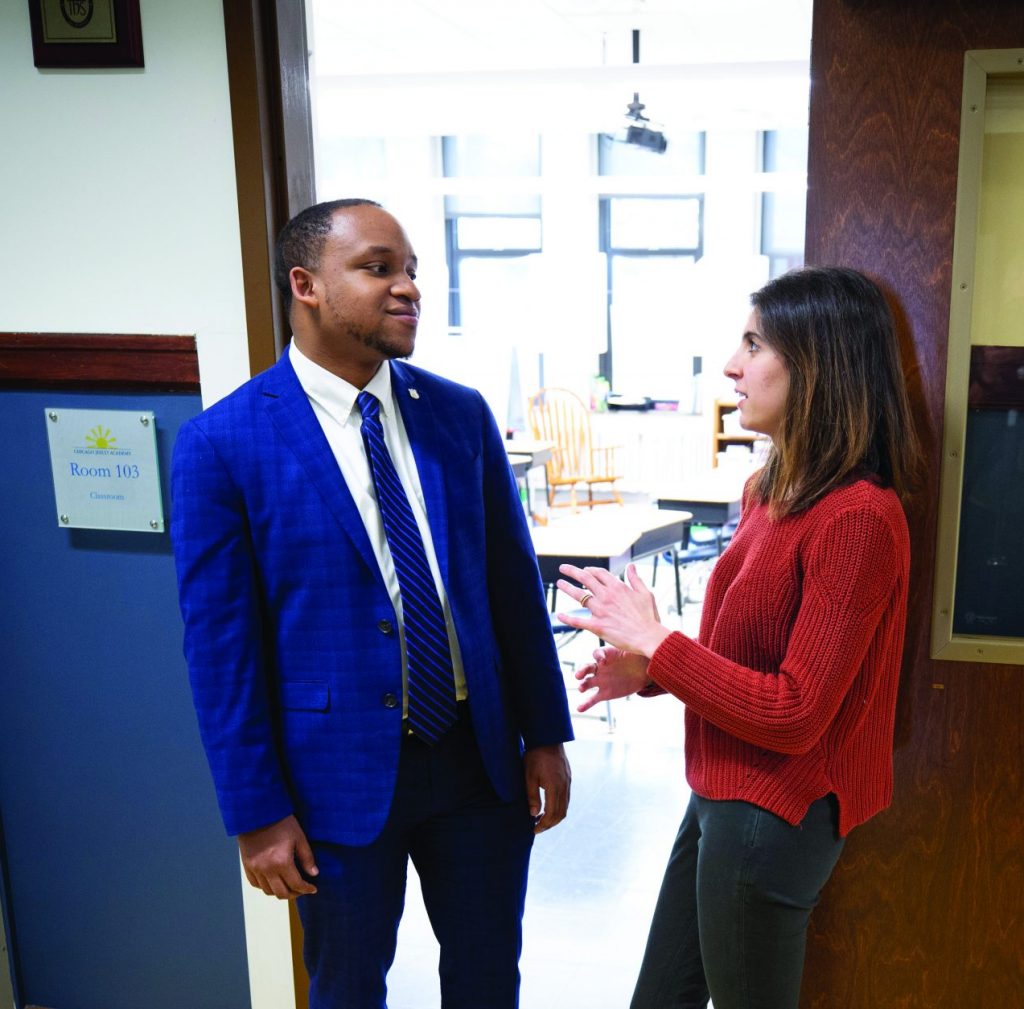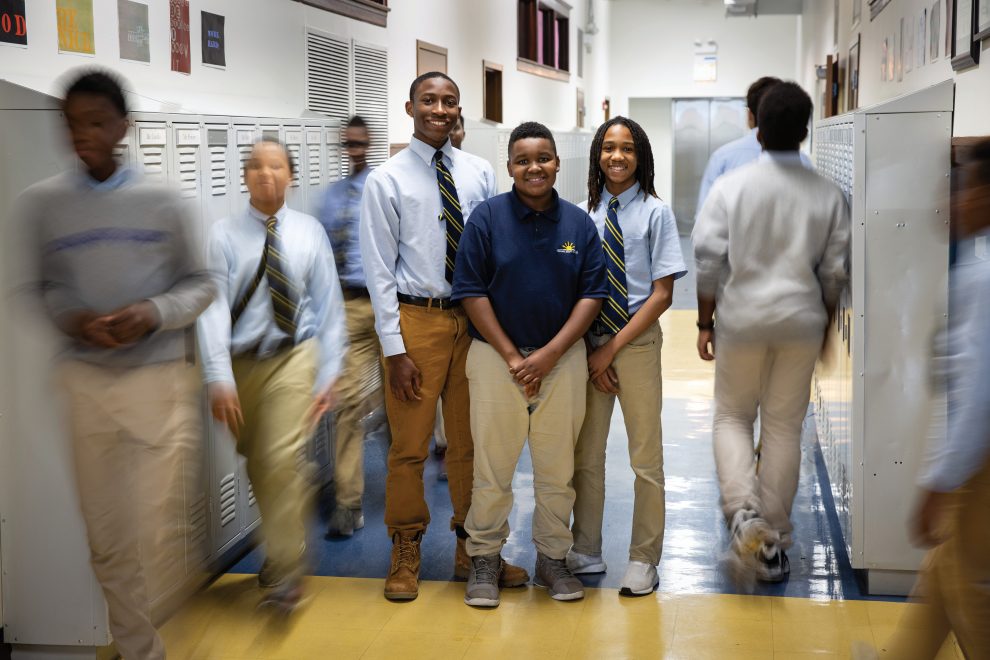Headmaster and Benedictine Father Edwin Leahy knew he was home when he walked through the doors of St. Benedict’s Preparatory School in Newark, New Jersey as a teenager. He graduated in 1963 and returned to the monastery in 1969 after the civil rights uprising that occurred in Newark two years prior. In 1972, when the school reopened after closing for a year, 26-year-old Leahy became the headmaster of a school no one else seemed to want, as the demographic had shifted from all white to predominantly Black and brown. Yet Leahy was as eager to usher the campus through change then as he is now.
Father Ed, as he is known, has made educating the diverse youth from an area wracked with dysfunction, poverty, and gang violence his life’s work. He believes it’s not always what you teach, but how you teach it. “We spend a lot of time tending to their hearts, because if you don’t deal with kids’ hearts you don’t have a chance,” Leahy says.

According to its mission statement, St. Benedict’s Prep works to “develop the mind, stretch the heart, form character, and nourish the spirit” of the students in its care. These, along with equality of all people, seem to be common themes in the majority of Catholic institutions across the nation. These ideals are upheld by Catholic social teaching yet are often at odds with recent stories that have surfaced from Catholic schools. The 2018 confirmation of Brett Kavanaugh to the Supreme Court of the United States, for example, along with the discovery of his high school yearbook from Georgetown Preparatory School and allegations of his sexual assault of Christine Blasey Ford, brought attention to elite all-male Catholic schools as a breeding ground for misogyny.
In another example, a 2019 report brought to light the fact that nuns from Georgetown Visitation Preparatory School, an elite all-female school also in Washington, D.C., had bought and sold slaves in the 1820s. We cannot change the past, but after review we can move forward with more integrity.
When we talk about the next generation of Catholic men and women, we need to understand that all of our decisions today—including how Catholic schools decide to engage with gender and other justice issues—will be a part of who they become. The schools that are rising to the challenge of raising competent, compassionate, and culturally aware young people are the ones that not only empower their students but also trust them and allow them to grow into their authentic selves. To form future generations of engaged Catholics, school offerings range from mere Band-Aid measures such as one-time lectures to broader efforts addressing issues of gender, race, and class within the context of Catholicism.
The schools that are rising to the challenge of raising competent, compassionate, and culturally aware young people are the ones that not only empower their students but also trust them and allow them to grow into their authentic selves.
For example, Matt Chen and Matias Benitez, students at the all-male Regis High School in New York City (which lauds National Institute of Allergy and Infectious Diseases director Dr. Anthony Fauci as an alum), started a HeForShe club in 2017, inspired by the #MeToo movement. This feminist group, which still operates at the school, addresses all types of gender topics at regular meetings. Others, like Leahy at St. Benedict’s Prep, are addressing issues head on and in real time and taking leaps of faith to form a counterculture of young men and women in the Catholic faith.
Community in action
“When I woke up this morning I knew I had a miracle,” Dennis Lansang, chair of the science department and St. Benedict’s one-man house band, sings from the lower right corner of my monitor, punctuating the early hour with a glissando for effect. The rest of the screen is a checkerboard of faces, some singing along. It was the first morning convocation of the school year at St. Benedict’s Prep, held on YouTube Live with more than 500 students, alumni, faculty, and staff present. It definitely wasn’t the usual in-person revival-style segment—and maybe it wasn’t a miracle—but morning convocation is the most important part of the day here. Even when held virtually, it helps effectively maintain the school community in 2020.
St. Benedict’s Prep doesn’t shy away from anything, educating students in the classroom and beyond with mentors and an on-campus counseling center. The school uses a unique leadership model that puts the students in charge of pretty much everything on a day-to-day basis. Similar to the Boy Scouts, students are placed in small groups, each with a leader and tiered into sections, and a senior leader presides over all. Positive peer pressure and peer motivation incentivize success and accountability. The adults don’t do for kids what the kids can do for themselves.
St. Benedict’s Prep isn’t just maintaining its community—the school is growing it with the addition of a girls division for the first time in its storied 152-year history. That part actually might be a miracle.

When nearby all-female Benedictine Academy abruptly announced its closing last spring, the teenagers affected (and the Holy Spirit, according to Leahy) went to work to find a solution. “These kids wanted community. They wanted stability. They wanted a place that was rooted in faith and in the Benedictine tradition, and they were eloquent in articulating what they wanted. There is no way I could tell these kids no,” Leahy says.
Senior and group leader Karen Calles was a catalyst for the new girls division. “The day we found out the school was going to close we decided to write a proposal to the boys at St. Benedict’s Prep, and that same week we went over and had a meeting with their leaders. There were no adults involved,” Calles says. “Everything that happens there is the decision of the students, and I knew if we could get their support and they could push Father Ed, that it was a possibility.”
The boys supported the idea, and Leahy was eventually brought in. With persistence, the girls saved themselves in the end, securing a place to continue their community. St. Benedict’s Prep operates on a year-round schedule, so there wasn’t much time to plan. When asked if he was running to get the school started, Leahy says, “No, I was running to catch up with the girls.”
Eric Duarte, a senior section leader, believes in equality and considers himself a feminist. “I have grown up around strong women and been raised by strong women. It is so important to recognize how strong the girls are who put this whole process in motion,” he says. Duarte is excited about the girls division and the dynamic it will add. St. Benedict’s Prep has no intention of going co-ed, but Leahy maintains that the girls will bring their own complementary views to the school, along with valuable opportunities for all students to interact within the leadership model.
Authentic masculinity
Calles emphasizes that she has not encountered the version of toxic masculinity often associated with all-male Catholic schools from any of the students at St. Benedict’s Prep. Perhaps that is by design, as Leahy and his team take every opportunity to encourage healthy relationships, mutual respect, and genuine individuality among the students. That isn’t to say toxic masculinity doesn’t exist elsewhere, but applying that general label to any typically male behavior is what Sean Kullman, president of the Global Initiative for Boys and Men, sees as part of the problem.
Kullman believes an authentic male narrative is more important now than ever. He makes a strong case for single-sex education, saying Catholic schools have the opportunity to lead the nation in advocating for boys and girls. But in order to do so they must embrace authentic masculinity. Kullman asserts that “terms such as toxic masculinity, patriarchy, and interloper are linked to a common rhetoric—designed to see the worst in inherent male behavior and presence. The phrase boys will be boys had everything to do with boys wrestling with one another, climbing trees, and the ways boys engage with their world.” He says, “We have allowed that once harmless phrase to progress to the detriment of our boys and men and conflate a social narrative that creates an archetypal image of the male as threatening. The overwhelming number of boys and men are not dangerous, not toxic, and do not have privilege.”
Kullman, a former educator and a Catholic father raising two sons with his wife, who he notes is the primary breadwinner, believes that the climate around boys and men has become more and more unforgiving over the past four decades. As girls are rightfully supported by education funding and grants, an Office on Women’s Health, and even a White House Council on Women and Girls, there is no White House Council on Boys and Men, Office on Men’s Health, or nearly the amount of funding anymore for boys. Statistics show boys are falling behind and getting lost.
Kullman believes an authentic male narrative is more important now than ever.
Advertisement
Single-sex education is not a common choice in our country and is not the answer for every child, but Kullman believes it is a choice that parents of all income levels should have. He points to data from the International Boys’ School Coalition showing boys will pursue their interests more openly in a single-sex environment. “There are always going to be distractions, but these distractions have more to do with maturity, rites of passage, and being mentored through them appropriately, which can happen more effectively in a single-sex classroom for some male and female students,” he says.
Matthew Lynch, president of Chicago Jesuit Academy (CJA), an all-boys school serving third through eighth graders on the West Side of Chicago, agrees. “Although it is not true across all students, the best educational research tells us that developmentally boys and girls are in very different places during the middle school years,” he says. “So being an all-boys school, especially during those years, we make it a little bit easier for a young man to be himself.” We live in a society where authenticity is hard to come by, yet it is critical to our physical and mental well-being. Therefore, we must find ways to nurture authenticity in today’s young men and women.
Grad at grad philosophy
Lynch explains that CJA chose an all-male model because reaching young men was an immediate need in the area, but an all-female version is a possibility in the future. The Nativity model of education at CJA, perhaps more so than the fact that it is all-male, is what makes the school unique. It provides an intimate, meaningful learning experience that works to help break cycles of poverty and systemic failures in low-income areas. The Jesuit graduate at graduation philosophy instilled is built on showing love, being open to growth, and being committed to doing justice.

Starting a middle school for boys was not something Lynch set out to do, but after a lifetime’s worth of complete Jesuit education culminating at Georgetown University, he went to work at a juvenile detention center and then at St. Ignatius Loyola Academy, a tuition-free, all-boys Jesuit middle school in Baltimore. There, he was inspired. Lynch, a Gen X Catholic, decided to apply those same Jesuit ideals in his hometown of Chicago, opening a school in the under-resourced Austin neighborhood on the city’s West Side when he was only 26 years old (coincidentally, the same age Leahy was when he took on St. Benedict’s Prep). Although the school only goes through eighth grade, college persistence counselors such as Katie DiPiero work with students and alumni through age 25. The counselors are able to see how students spend their time at CJA and how that affects their lives afterward.
While many CJA students are not Catholic, most do identify as Christian. Lynch says, “Our intention is always to be a fully Jesuit and Catholic school, and there is always the invitation to the Catholic faith.” CJA works to educate the whole person and puts responsibilities on the students. The school embeds Catholic ideals into the environment and encourages tools such as praying the Daily Examen. Lynch says that middle school students especially have a finely tuned radar for what is real and authentic. He works to model by actions, referring to the words of St. Francis, “Preach the gospel at all times, use words when necessary.”
“I think part of the larger work we are trying to accomplish is to help our students know that they belong and that we will always stand with them to help them sort through various challenges that come their way.”
Advertisement
Lynch agrees that even in younger grades, and especially in urban schools, educators must deliberately create space for conversations around gender, race, and all of the ways we are different from one another. “I don’t pretend we have found any answers to those challenges. Especially in the wake of the George Floyd murder, this is a time to have the humility to look at all that we do with fresh eyes and say where are we coming up short and where can we do more,” he says.
Race issues are a part of the social-emotional curricular work at the school, and the College-Persistence Team dove deep into current issues this past summer over weekly Zoom meetings with alumni. Lynch says, “A huge part of our job as educators is moments like that, to help students process through it. In so many schools there isn’t time and resources and capacity to do that well. I think part of the larger work we are trying to accomplish is to help our students know that they belong and that we will always stand with them to help them sort through various challenges that come their way.”
There are plenty of examples of CJA grads out there doing the work. DiPiero points to 20-year- old alum Alzario Palmer, who led a peaceful protest for the Black Lives Matter movement. When asked about the role CJA plays in such stories, she says, “They aren’t these wonderful young men because they went to CJA. They are just wonderful young men, and we are lucky enough to be a part of their story for a while.” Her coworker Meredith Mosbacher, a development officer at CJA, says, “What [the students] are doing is
through their own strength and resilience. They are the ones doing the work.”
Agents of change
All-female Catholic schools are also changing how they address topics of gender, race, and other social issues. Ursuline Academy of New Orleans is the oldest Catholic school and longest continually operating school for girls in the nation. The Sisters of the Order of St. Ursula established the school in 1727, founded on the values of St. Angela Merci who saw women as significant agents of change in the world. Christy Jackson Zurcher, director of communications, says, “The Ursulines believed, and still believe, in educating all women. They provided the first convent, the first free school, the first retreat center for ladies, and the first classes for enslaved African American women, free women of color, and Native Americans.”
With classes currently spanning from toddler age to the twelfth grade, educators and mentors at Ursuline Academy don’t mind getting their hands dirty in order to enlighten young women on the importance of their contribution. Last January the first graders got busy making and selling slime for a social studies cross-curricular project on economics and entrepreneurship. In a partnership with local all-boys Brother Martin High School, Ursuline Academy was the only all-female school in the nation to offer Navy Junior ROTC this past year.

The protests for racial justice over the summer were a wake-up call for many institutions. The high school division of Ursuline Academy (whose student body is about 35 percent nonwhite) has had a Diversity of Women Club and a No Place for Hate
designation through the Anti-Defamation League, yet did not waste the opportunity to find a humble teaching moment. It quickly formed a Diversity, Inclusion, and Belonging Task Force open to the entire community, with the ultimate goal of assessing the governance, operational structures, and all areas of school life to create an inclusive and welcoming community with enhanced cultural competence skills.
“Our girls are encouraged to take risks, ask questions, and wrestle with mistakes to find new solutions. We believe that it is important to develop female leaders of confidence and compassion. We strive to nurture culturally competent young women to prepare them for life in a global society,” says Zurcher.
Back in Newark, Father Edwin Leahy operates according to an invigorating idea: shut up and listen. He says, “People need to take the cotton out of their ears and put it in their mouths.” There is plenty of talk about defining Catholic men and women, but Leahy is more interested in the actual work being done. “We have to be able to listen to how we can help others,” he says. When asked to consider the next generation of Catholics, he references a line from Martin Luther King Jr.: They will not be judged by the color of their skin, but by the content of their character. “The next generation of Catholic men is much more interested in collaboration,” says Leahy. “I think you will see girls push for much more meaningful roles in the church, and I think you’ll see many guys who support it.”
In Chicago, Matthew Lynch admits that there are instances when the human institution of the Catholic Church comes up short. That presents difficult conversations, especially around the constraints still imposed on women. But, he says, “We can never put God in a box.” He acknowledges the mystery of Christ and wants every child to know they are invited to the table of the Lord. “It is life-giving, and I want them to have access to that grace,” he says.
This article also appears in the October issue of U.S. Catholic (Vol. 85, No. 10, pages 31-35). Click here to subscribe to the magazine.
Image: Steve Donisch














Add comment